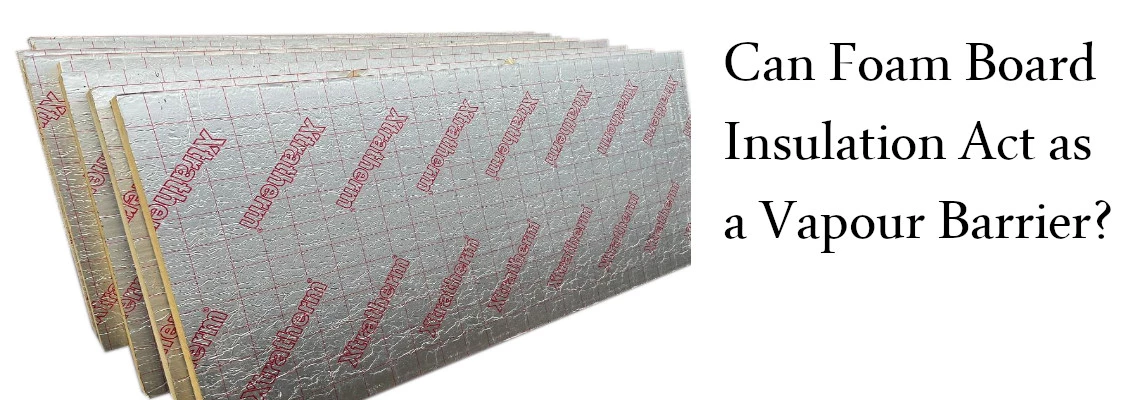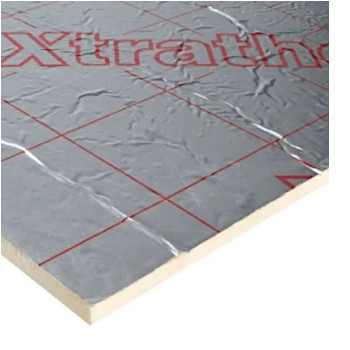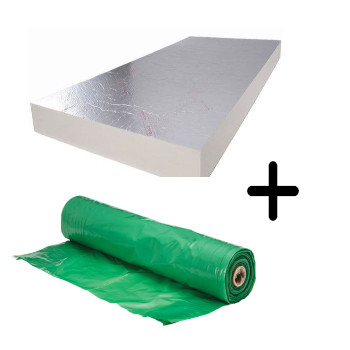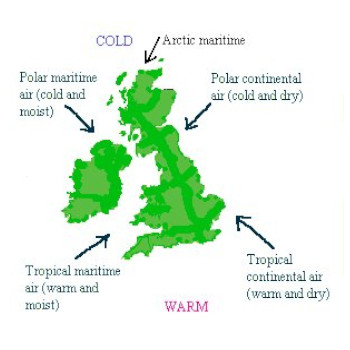
UNDERSTANDING FOAM RIGID INSULATION AND VAPOUR BARRIERS. WHAT YOU NEED TO KNOW*
Foam rigid insulation such as Celotex, Kingspan or Xtratherm has become a popular choice for many homeowners due to its energy efficiency and thermal performance. However, when it comes to installing foam rigid insulation, one question that arises is whether a vapour barrier is needed. In this blog post, we will explore the role of vapour barriers that comes with foam rigid insulation and discuss the advantages and disadvantages of using this type of insulation. We will examine how the aluminium foil on foam insulation boards functions as a vapour barrier, how it reflects heat, and discuss the benefits and drawbacks of using this type of insulation.
By the end of this blog post, readers will have a better understanding of the different options available for foam insulation and how to choose the best insulation solution for their needs.
 Table of Contents:
Table of Contents:
- UNDERSTANDING FOAM RIGID INSULATION AND VAPOUR BARRIERS. WHAT YOU NEED TO KNOW
- THE ROLE OF WATER VAPOUR IN THERMAL INSULATION
- UNDERSTANDING THE COMPOSITION AND FUNCTION OF RIGID INSULATION FOAM BOARDS AND THEIR ALUMINIUM FOIL LAYER
- DOES FOAM RIGID INSULATION NEED A VAPOUR BARRIER?
- ATTACHING VAPOUR BARRIER TO FOAM BOARD
- THE DISADVANTAGES OF RIGID FOAM INSULATION
- CAN FOAM BOARD INSULATION ACT AS A VAPOUR BARRIER?
- COMBINING RIGID FOAM AND BATT INSULATION
- WHEN TO USE A VAPOUR BARRIER WITH INSULATION
- FOAM BOARD INSULATION WITH VAPOUR BARRIER
THE ROLE OF WATER VAPOUR IN THERMAL INSULATION
 Water vapour plays an important role in the thermal insulation of a building. When water vapour penetrates into insulation materials, it can reduce their insulating properties and potentially cause damage to the building structure. Therefore, it is essential to manage water vapour effectively in order to maintain the thermal performance of insulation and prevent problems such as condensation and mould growth.
Water vapour plays an important role in the thermal insulation of a building. When water vapour penetrates into insulation materials, it can reduce their insulating properties and potentially cause damage to the building structure. Therefore, it is essential to manage water vapour effectively in order to maintain the thermal performance of insulation and prevent problems such as condensation and mould growth.
One way to manage water vapour is to use a vapour barrier. A vapour barrier is a material that is impermeable to water vapour and is placed on the warm side of the insulation. This helps to prevent water vapour from entering the insulation, where it could condense and cause damage.
However, it is important to note that while a vapour barrier can be effective in preventing moisture issues, it can also create problems if installed incorrectly.
If a vapour barrier is placed on the wrong side of the insulation or is not sealed properly, it can trap moisture inside the wall or roof assembly, leading to rot, corrosion, and other problems.
Another way to manage water vapour is to use insulation materials that are vapour-permeable, meaning that they allow water vapour to pass through. This can be particularly important in climates where the humidity level is high or where there is a lot of moisture in the air, such as in coastal regions. Examples of vapour-permeable insulation materials include mineral wool and open-cell spray foam.
In summary, the role of water vapour in thermal insulation cannot be ignored. It is important to manage it effectively through the use of proper insulation materials and vapour barriers to maintain the thermal performance of the building and prevent moisture-related problems.
Read more: 7 types of Mambranes that couse more problems than solve?
UNDERSTANDING THE COMPOSITION AND FUNCTION OF RIGID INSULATION FOAM BOARDS AND THEIR ALUMINIUM FOIL LAYER
 Rigid insulation foam boards, such as Celotex, Kingspan or Xtratherm, are typically made by combining various materials, such as polyurethane or polyisocyanurate foam, with additives and binders. These materials are then formed into a board-like shape, which can be cut to size and shape as needed.
Rigid insulation foam boards, such as Celotex, Kingspan or Xtratherm, are typically made by combining various materials, such as polyurethane or polyisocyanurate foam, with additives and binders. These materials are then formed into a board-like shape, which can be cut to size and shape as needed.
The aluminium foil on foam insulation boards serves several purposes. One of the main purposes is to act as a vapour barrier, preventing moisture from penetrating the insulation and potentially causing damage or reducing the insulation's effectiveness. Additionally, the foil can help reflect radiant heat, improving energy efficiency and reducing heating and cooling costs. The foil may also provide a protective layer to help prevent damage to the insulation from UV radiation, chemicals or other environmental factors.
Overall, the aluminium foil layer is an important component of foam insulation boards, helping to improve their performance and durability. It is important to note that proper installation is critical to ensure the vapour barrier functions as intended, so it is recommended to consult with insulation professionals or follow manufacturer guidelines when installing foam insulation boards with aluminium foil.
DOES RIGID FOAM INSULATION NEED A VAPOUR BARRIER?
The short answer is - it depends. In general, if the foam rigid insulation is installed correctly and sealed properly, a vapour barrier may not be necessary. However, there are certain situations where a vapour barrier is recommended, such as in areas with high humidity levels or where there is a risk of moisture infiltration.
Here are some examples and details that expand on the topic of whether rigid foam insulation needs a vapour barrier
Cold climates
In colder climates, it is important to prevent moisture from penetrating the insulation layer, as this can lead to condensation and potentially cause damage or reduce the insulation's effectiveness. In these cases, an extra vapour barrier is often recommended to prevent moisture from seeping into the insulation layer.
High humidity levels
In areas with high humidity levels, such as bathrooms, laundry rooms or kitchens, a vapour barrier is typically recommended to prevent moisture from building up and causing damage. This is particularly important for PIR foam insulation, as the foam material can absorb moisture and potentially degrade over time, especially at joints or gaps where moisture can infiltrate.
Improper installation
Even if PIR foam insulation is designed to be a vapour barrier, if it is not installed correctly, it may not function as intended. Improper installation can result in gaps or holes in the insulation layer, which can allow moisture to seep through. In these cases, a separate vapour barrier may be needed to ensure adequate moisture control.
Combination with other insulation types
In some cases, PIR rigid foam insulation may be combined with other types of insulation, such as batt insulation. In these situations, it may be necessary to use a vapour barrier to ensure proper moisture control and prevent moisture from building up between the insulation layers.
Overall, whether or not a vapour barrier is needed with PIR foam rigid insulation depends on a variety of factors, including climate, humidity levels and installation quality.
It is important to consult with insulation professionals or follow manufacturer guidelines to determine the best insulation solution for a specific project.
ATTACHING VAPOUR BARRIER TO FOAM BOARD
If a vapour barrier is required, it can be attached over the foam insulation. If the vapour barrier is placed over the insulation, it will need to be sealed carefully to prevent any moisture from entering.
When attaching a vapour barrier to foam board insulation, it is important to ensure a proper fit and seal to prevent any moisture from penetrating. One option is to use adhesive tape to attach the vapour barrier directly to the foam board. This is a common method and is effective when installed properly.
THE DISADVANTAGES OF RIGID FOAM INSULATION
While rigid foam insulation can be an effective method for insulating a building, there are some potential disadvantages to consider, especially in terms of vapour barriers.
One potential disadvantage is that rigid foam insulation can be more difficult to install than other types of insulation. This is because it requires precise cutting and fitting, as well as careful sealing at all joints and edges to prevent air infiltration and ensure proper vapour barrier protection. To find out how to cut PIR isulation clik here
Another disadvantage is that rigid foam insulation can be more prone to moisture buildup and damage than other types of insulation. This is particularly true if the insulation is not installed properly or if there are gaps or cracks in the insulation, which can allow moisture to infiltrate and potentially lead to mould growth, rot, or other forms of water damage.
Furthermore, rigid foam insulation may not be suitable for all building applications, such as in areas with high seismic activity or in buildings with complex or irregular shapes, due to its relatively inflexible nature.
Overall, while rigid foam insulation can offer several benefits in terms of energy efficiency and insulation performance, it is important to carefully weigh the potential disadvantages, especially in terms of vapour barrier protection, when considering this type of insulation for a particular building project.
CAN PIR FOAM BOARD INSULATION ACT AS A VAPOUR BARRIER ITSELF?
Polyisocyanurate (PIR) foam board insulation has a relatively low permeability, meaning it can resist the passage of moisture to a certain extent. However, it is not typically recommended to rely on PIR foam board insulation as a standalone vapour barrier.
While the foam board insulation can slow the movement of moisture through it, it is not completely impermeable, and moisture can still potentially penetrate the material over time. Additionally, any joints or seams in the insulation can create areas of vulnerability where moisture may be able to infiltrate.
Therefore, it is generally recommended to use a separate vapour barrier in conjunction with PIR foam board insulation in order to provide adequate moisture protection.
This can help to ensure that the insulation remains effective and does not degrade over time due to moisture infiltration.
COMBINING RIGID FOAM AND BATT INSULATION
Combining rigid foam and batt insulation is a common approach to insulation in many buildings. This method involves using rigid foam insulation as the primary insulation layer and batt insulation as a secondary layer. The rigid foam insulation is typically installed on the exterior of the building, while the batt insulation is installed within the wall or ceiling cavities.
When using this approach, it is important to ensure that the vapour barrier is installed correctly. The vapour barrier should be installed on the warm side of the insulation to prevent moisture from penetrating the insulation and potentially causing damage or reducing the insulation's effectiveness.
One potential disadvantage of this approach is that it can be more difficult to achieve an effective vapour barrier when combining rigid foam and batt insulation. The batt insulation can create gaps or voids within the insulation layer, which can allow moisture to enter and potentially cause issues.
Additionally, combining rigid foam and batt insulation can be more expensive than using one type of insulation alone. However, this approach can provide a higher level of insulation and energy efficiency, particularly in colder climates where insulation is particularly important.
Overall, combining rigid foam and batt insulation can be an effective insulation strategy, but it is important to ensure that the vapour barrier is installed correctly to prevent moisture issues. It is also important to consider the cost and benefits of this approach compared to other insulation options.
WHEN TO USE A VAPOUR BARRIER WITH INSULATION?
 A vapour barrier is recommended in situations where there is a risk of moisture infiltration or high humidity levels. For example, in regions with cold winters and warm summers, a vapour barrier is typically necessary to prevent moisture from entering the insulation during the winter and getting trapped inside during the summer, which can lead to mold growth, rot, and other issues.
A vapour barrier is recommended in situations where there is a risk of moisture infiltration or high humidity levels. For example, in regions with cold winters and warm summers, a vapour barrier is typically necessary to prevent moisture from entering the insulation during the winter and getting trapped inside during the summer, which can lead to mold growth, rot, and other issues.
In general, a vapour barrier should be installed on the warm side of the insulation, which is typically the interior of the building. However, in some cases, such as in hot and humid climates, it may be necessary to install a vapour barrier on the exterior side of the insulation to prevent moisture from entering the wall assembly.
Here are some examples of different climates and countries and their varying needs for vapour barriers with insulation:
UK: The UK has a temperate maritime climate, with relatively mild winters and cool summers. Due to the high levels of precipitation and humidity, vapour barriers are often recommended when installing foam insulation to prevent moisture from entering the building envelope.
Spain: Spain has a Mediterranean climate, with hot, dry summers and mild, wet winters. In this climate, vapour barriers are less commonly used due to the low humidity levels. However, in areas with high humidity or near coastal regions, vapour barriers may still be necessary to prevent moisture infiltration.
Canada: Canada has a diverse range of climates, from cold, snowy winters in the north to mild, rainy winters in the west coast. In all climates, vapour barriers are typically recommended when installing insulation to prevent moisture from entering the building envelope and causing damage.
United States: The United States also has a diverse range of climates, from the hot, humid south to the cold, dry north. In general, vapour barriers are recommended in areas with high humidity or where there is a risk of moisture infiltration, such as coastal regions or areas prone to flooding.
It is important to consider the specific climate and environmental conditions when determining whether a vapour barrier is necessary with insulation, and to follow local building codes and regulations.
FOAM BOARD INSULATION WITH VAPOUR BARRIER
Foam board insulation with a built-in vapour barrier can be a convenient and effective solution for preventing moisture infiltration and improving energy efficiency. These types of insulation boards typically have an aluminium foil layer on one side that acts as a vapour barrier.
Foam board insulation with a vapour barrier is particularly useful in areas with high humidity levels, where moisture infiltration can be a significant problem. In these situations, installing a separate vapour barrier can be time-consuming and costly, and a foam board insulation with a built-in vapour barrier can provide a more efficient solution.
It is important to note that foam board insulation with a vapour barrier may not be suitable for all applications. For example, in areas with very low humidity levels, a separate vapour barrier may not be necessary, and using a foam board insulation with a built-in vapour barrier may result in excessive moisture retention and potential mould growth.
In countries like the UK and Spain, where the climate can be damp and humid, foam board insulation with a vapour barrier is commonly used in building insulation applications. In the UK, for example, it is common practice to install foam board insulation with a vapour barrier in external walls, roofs, and floors to prevent moisture infiltration and improve energy efficiency. In Spain, where the climate is typically warm and humid, foam board insulation with a vapour barrier is often used in walls and roofs to prevent moisture infiltration and improve thermal insulation.
Related articles:
Vapout control layer. Dark side
Building regulation. Part L changes
How to prevent window condesation?
Refelctive foil insulation benefits
How to cut PIR insulation board?
*All the information provided in the content published on Insulationgo blog is for informational and educational purposes only. Insulationgo LTD makes every effort to ensure the accuracy and timeliness of the content, but we do not assume any responsibility for any errors or omissions.
The information presented on this blog should not be considered as professional advice or a substitute for consulting relevant experts. Before making any purchase decisions or taking action based on the information presented here, it is strongly recommended to contact the product manufacturer directly to verify the details and ensure its suitability for your specific needs.
By using this blog, you acknowledge and agree that Insulationgo LTD shall not be held liable for any damages, losses, or inconveniences arising from the use or reliance on the information provided herein. This limitation of liability applies to all users of the blog, including but not limited to visitors, readers, and subscribers.










































































































